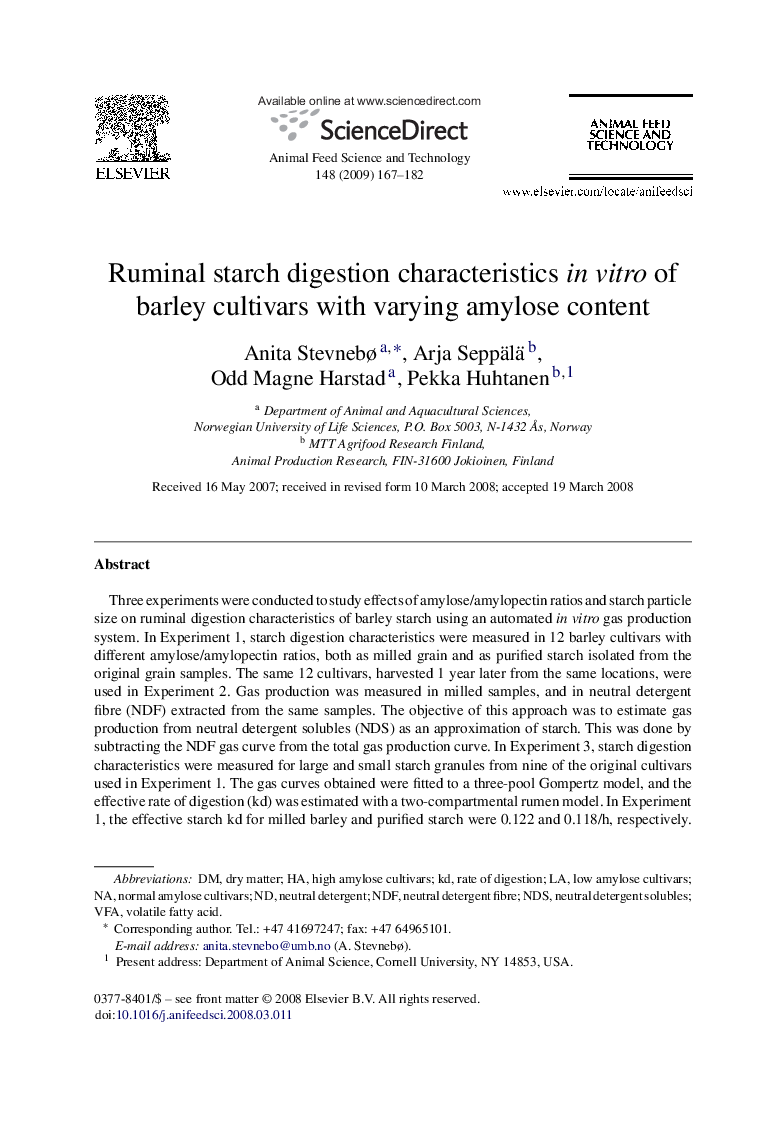| کد مقاله | کد نشریه | سال انتشار | مقاله انگلیسی | نسخه تمام متن |
|---|---|---|---|---|
| 2420604 | 1552463 | 2009 | 16 صفحه PDF | دانلود رایگان |

Three experiments were conducted to study effects of amylose/amylopectin ratios and starch particle size on ruminal digestion characteristics of barley starch using an automated in vitro gas production system. In Experiment 1, starch digestion characteristics were measured in 12 barley cultivars with different amylose/amylopectin ratios, both as milled grain and as purified starch isolated from the original grain samples. The same 12 cultivars, harvested 1 year later from the same locations, were used in Experiment 2. Gas production was measured in milled samples, and in neutral detergent fibre (NDF) extracted from the same samples. The objective of this approach was to estimate gas production from neutral detergent solubles (NDS) as an approximation of starch. This was done by subtracting the NDF gas curve from the total gas production curve. In Experiment 3, starch digestion characteristics were measured for large and small starch granules from nine of the original cultivars used in Experiment 1. The gas curves obtained were fitted to a three-pool Gompertz model, and the effective rate of digestion (kd) was estimated with a two-compartmental rumen model. In Experiment 1, the effective starch kd for milled barley and purified starch were 0.122 and 0.118/h, respectively. Barley cultivars with low amylose (LA) had a higher effective kd (0.148/h) compared with cultivars with normal amylose (NA) (0.115/h) and high amylose (HA) (0.102/h) (P=0.010). Results obtained with milled barley were supported by the purified barley starch sample results, but differences were smaller and only numerically different. In Experiment 2, the ranking of the amylose groups was consistent with those in Experiment 1 (i.e., LA > NA > HA) (P=0.096). However, these differences were not reflected in the effective kd for the NDS fraction (P=0.366). Thus, factors other than those related to starch per se, or other structural features, are apparently important. Barley cultivars in the LA group had a higher effective kd for aNDF (0.098/h) than did NA and HA barley (0.060 and 0.055/h, respectively). Thus, the effect of the amylose group on the effective kd for aNDF corresponded well with the milled barley results. The NDF fraction, directly or indirectly, has a clear impact on the ruminal digestion rate of barley starch. There was no difference in the effective kd for starch between the small (0.126/h) and large (0.129/h) starch granules.
Journal: Animal Feed Science and Technology - Volume 148, Issues 2–4, 16 January 2009, Pages 167–182